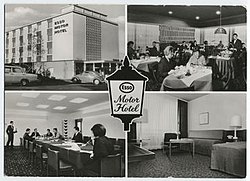Esso Motor Hotel
 |
|
|
Native name
|
Motorby |
|---|---|
| Founded | 1963 in Laxå, Sweden |
| Services | Rest stops for travelers by car |
Esso Motor Hotel was a Swedish subsidiary of the American oil company Esso, for running hotels in Europe.
In the sixties of the twentieth century, with the rise of the numbers of travelers by car, the Scandinavian governments asked for dormitories for motorists at the service stations along the highways. The first that offered bedrooms to motorists was the Swedish Esso filling station along the E20 in Laxå, halfway between and Göteborg, resulting in a complete Motorby in 1963 and the establishing of Esso Motor Hotel AB. A Motorby (Swedish for Motor village), is a filling station with workshop combined with a hotel specially for motorists with direct access from the parking to the rooms. All rooms and services, as a shop and cafeteria, are situated at ground floor level. The first motorby at Laxå was followed soon by motorbys at Härnosand, Östersund and Vara and a motel in Örkelljunga. The later built Esso Motor Hotels were provided with far more features than a motorby, as a waiter served restaurant, bank, fitness room, sauna, pool and meeting rooms, mainly to satisfy business travelers. The first three motorbys were upgraded to Esso Motor Hotel, but Vara and Örkelljunga were rated as Esso Motel with minimized services.
Until the splitting at the beginning of 1973, 59 Esso Motor Hotels were opened: 27 in Sweden, 3 in Norway, 2 in Denmark, 3 in the Netherlands, 3 in Italy, 8 in the United Kingdom (notably at Wembley Park, Wembley), 1 in Austria, 10 in Germany and 2 in Belgium. The chain had an internal reservation system by which the customer could book the Esso Motor Hotel for the next stage of his journey. The hotels outside Scandinavia were managed by Esso Motor Hotel inc. in London.
After the first three motor hotels in Sweden expansion abroad followed in 1965. The Scandinavian holidaymaker should be able to drive to the Italian coast using Esso Motor Hotels during the journey. The Hotels were situated in a one-day driving distance from each other. The northern end of this "Esso route" was Mölndal in Sweden which opened in 1966, the southern end was Brescia in Italy which opened in 1965. The Swedish-Danish bordercrossing was made by ferry at Helsingborg, from Denmark to Germany the route followed the, then new, Vogelfluglinie. In Germany the HaFraBa autobahn route was chosen and south of Basle the route of the present E25 through Switzerland, France and the new Mont Blanc Tunnel. In Italy Brescia was reached through Valle d'Aosta and the Autostrada Serenissima. The intermediate hotels were situated in Hannover, Courmayeur, Freiburg and Glostrup (Copenhagen). From Brescia the tourists could follow their way to the various resorts on the Adriatic in Italy as well as in Yugoslavia. More differentiation was created in 1967 by two more Hotels, Heidelberg and Sindelfingen in the south of Germany. In Sweden the hotels at Nörrköping and Jönköping were opened in 1967 too. These two enabled the travellers from and to Stockholm to follow the direct route from Stockholm to Helsingborg instead of the longer one via Laxå and Mölndal. In 1969 the southern end shifted to Florence, but Esso's Italian partner Pavesi built five hotels between Florence and Sicily. From the initial plan for the route from Trondheim in the North to Sicily in the South only the hotel in Trondheim was added afterwards.
...
Wikipedia
